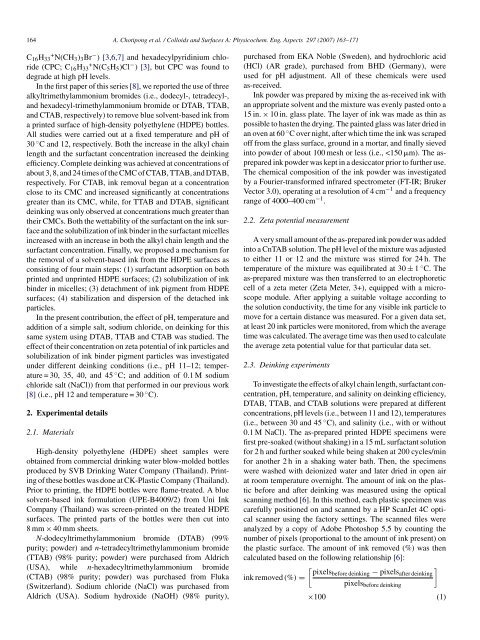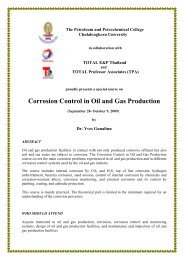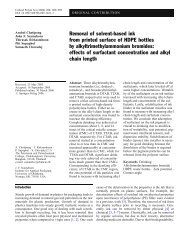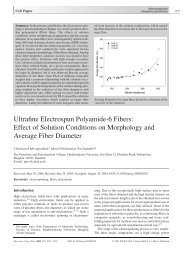Removal of solvent-based ink from printed surface - The Petroleum ...
Removal of solvent-based ink from printed surface - The Petroleum ...
Removal of solvent-based ink from printed surface - The Petroleum ...
You also want an ePaper? Increase the reach of your titles
YUMPU automatically turns print PDFs into web optimized ePapers that Google loves.
164 A. Chotipong et al. / Colloids and Surfaces A: Physicochem. Eng. Aspects 297 (2007) 163–171<br />
C16H33 + N(CH3)3Br − ) [3,6,7] and hexadecylpyridinium chloride<br />
(CPC; C16H33 + N(C5H5)Cl − ) [3], but CPC was found to<br />
degrade at high pH levels.<br />
In the first paper <strong>of</strong> this series [8], we reported the use <strong>of</strong> three<br />
alkyltrimethylammonium bromides (i.e., dodecyl-, tetradecyl-,<br />
and hexadecyl-trimethylammonium bromide or DTAB, TTAB,<br />
and CTAB, respectively) to remove blue <strong>solvent</strong>-<strong>based</strong> <strong>ink</strong> <strong>from</strong><br />
a <strong>printed</strong> <strong>surface</strong> <strong>of</strong> high-density polyethylene (HDPE) bottles.<br />
All studies were carried out at a fixed temperature and pH <strong>of</strong><br />
30 ◦ C and 12, respectively. Both the increase in the alkyl chain<br />
length and the surfactant concentration increased the de<strong>ink</strong>ing<br />
efficiency. Complete de<strong>ink</strong>ing was achieved at concentrations <strong>of</strong><br />
about 3, 8, and 24 times <strong>of</strong> the CMC <strong>of</strong> CTAB, TTAB, and DTAB,<br />
respectively. For CTAB, <strong>ink</strong> removal began at a concentration<br />
close to its CMC and increased significantly at concentrations<br />
greater than its CMC, while, for TTAB and DTAB, significant<br />
de<strong>ink</strong>ing was only observed at concentrations much greater than<br />
their CMCs. Both the wettability <strong>of</strong> the surfactant on the <strong>ink</strong> <strong>surface</strong><br />
and the solubilization <strong>of</strong> <strong>ink</strong> binder in the surfactant micelles<br />
increased with an increase in both the alkyl chain length and the<br />
surfactant concentration. Finally, we proposed a mechanism for<br />
the removal <strong>of</strong> a <strong>solvent</strong>-<strong>based</strong> <strong>ink</strong> <strong>from</strong> the HDPE <strong>surface</strong>s as<br />
consisting <strong>of</strong> four main steps: (1) surfactant adsorption on both<br />
<strong>printed</strong> and un<strong>printed</strong> HDPE <strong>surface</strong>s; (2) solubilization <strong>of</strong> <strong>ink</strong><br />
binder in micelles; (3) detachment <strong>of</strong> <strong>ink</strong> pigment <strong>from</strong> HDPE<br />
<strong>surface</strong>s; (4) stabilization and dispersion <strong>of</strong> the detached <strong>ink</strong><br />
particles.<br />
In the present contribution, the effect <strong>of</strong> pH, temperature and<br />
addition <strong>of</strong> a simple salt, sodium chloride, on de<strong>ink</strong>ing for this<br />
same system using DTAB, TTAB and CTAB was studied. <strong>The</strong><br />
effect <strong>of</strong> their concentration on zeta potential <strong>of</strong> <strong>ink</strong> particles and<br />
solubilization <strong>of</strong> <strong>ink</strong> binder pigment particles was investigated<br />
under different de<strong>ink</strong>ing conditions (i.e., pH 11–12; temperature<br />
= 30, 35, 40, and 45 ◦ C; and addition <strong>of</strong> 0.1 M sodium<br />
chloride salt (NaCl)) <strong>from</strong> that performed in our previous work<br />
[8] (i.e., pH 12 and temperature = 30 ◦ C).<br />
2. Experimental details<br />
2.1. Materials<br />
High-density polyethylene (HDPE) sheet samples were<br />
obtained <strong>from</strong> commercial dr<strong>ink</strong>ing water blow-molded bottles<br />
produced by SVB Dr<strong>ink</strong>ing Water Company (Thailand). Printing<br />
<strong>of</strong> these bottles was done at CK-Plastic Company (Thailand).<br />
Prior to printing, the HDPE bottles were flame-treated. A blue<br />
<strong>solvent</strong>-<strong>based</strong> <strong>ink</strong> formulation (UPE-B4009/2) <strong>from</strong> Uni Ink<br />
Company (Thailand) was screen-<strong>printed</strong> on the treated HDPE<br />
<strong>surface</strong>s. <strong>The</strong> <strong>printed</strong> parts <strong>of</strong> the bottles were then cut into<br />
8mm× 40 mm sheets.<br />
N-dodecyltrimethylammonium bromide (DTAB) (99%<br />
purity; powder) and n-tetradecyltrimethylammonium bromide<br />
(TTAB) (98% purity; powder) were purchased <strong>from</strong> Aldrich<br />
(USA), while n-hexadecyltrimethylammonium bromide<br />
(CTAB) (98% purity; powder) was purchased <strong>from</strong> Fluka<br />
(Switzerland). Sodium chloride (NaCl) was purchased <strong>from</strong><br />
Aldrich (USA). Sodium hydroxide (NaOH) (98% purity),<br />
purchased <strong>from</strong> EKA Noble (Sweden), and hydrochloric acid<br />
(HCl) (AR grade), purchased <strong>from</strong> BHD (Germany), were<br />
used for pH adjustment. All <strong>of</strong> these chemicals were used<br />
as-received.<br />
Ink powder was prepared by mixing the as-received <strong>ink</strong> with<br />
an appropriate <strong>solvent</strong> and the mixture was evenly pasted onto a<br />
15 in. × 10 in. glass plate. <strong>The</strong> layer <strong>of</strong> <strong>ink</strong> was made as thin as<br />
possible to hasten the drying. <strong>The</strong> painted glass was later dried in<br />
anovenat60 ◦ C over night, after which time the <strong>ink</strong> was scraped<br />
<strong>of</strong>f <strong>from</strong> the glass <strong>surface</strong>, ground in a mortar, and finally sieved<br />
into powder <strong>of</strong> about 100 mesh or less (i.e.,





